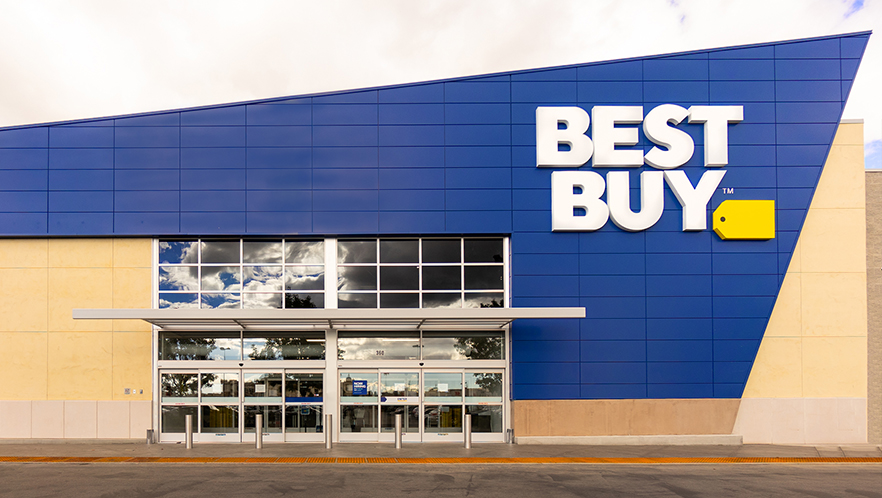
Best Buy on Thursday reported fiscal fourth-quarter sales that fell short of expectations, as it was hamstrung by supply chain challenges and omicron-related staffing shortages.
But the company’s shares rose, as executives painted a rosier picture of the years ahead and investors bet that sales gains made during the Covid pandemic will outlast near-term hiccups.
The stock climbed more than 10% in early trading. Best Buy is lapping challenging year-over-year comparisons when the pandemic and stimulus checks fueled sales.
CEO Corie Barry said in an earnings presentation that the retailer had low inventory on some popular holiday items and reduced store hours in the fourth quarter. Yet she said the company hit its fastest ever holiday delivery times and zeroed in on key growth areas like its membership program, Totaltech, and health business.
She said Best Buy leaders are “deliberately investing in our future and furthering our competitive differentiation,” even if that weighs on short-term profits.
Barry also said the pandemic has turned telemedicine, online fitness and videoconferencing into permanent parts of consumers’ lives — laying the groundwork for a bright future.
“We do not for one minute believe we hit our peak revenue and margin this past year,” she said.
Here’s how the company did for its fiscal fourth quarter of 2022, ended Jan. 29, compared with what Wall Street was expecting, based on a survey of analysts by Refinitiv:
- Earnings per share: $2.73 adjusted vs. $2.73 expected
- Revenue: $16.37 billion vs. $16.6 billion expected
Best Buy’s net income dropped to $626 million, or $2.62 per share, from $816 million, or $3.10 per share, a year earlier. Excluding items, it earned $2.73 per share, matching the $2.73 expected by analysts surveyed by Refinitiv.
Net sales decreased to $16.37 billion from $16.94 billion a year earlier, missing estimates of $16.6 billion.
Same-store sales fell 2.3% during the quarter, underperforming analysts’ and the company’s own expectations. Analysts anticipated that same-store sales would decrease 0.9%, and the company predicted they would come in at a range of a 2% decline to 1% growth.
A pandemic beneficiary
Best Buy saw its sales and stock price surge during the pandemic as it catered to Americans’ needs, such as extra computer monitors and printers for working at home, cooking appliances for more dining-in, and home theater systems and gaming consoles to pass the time.
Now, some investors have bet on the retailer’s sales moderating or dropping off as people return to the office and opt for in-person gatherings instead of sitting behind screens.
Best Buy has managed through headwinds in recent quarters, including chip shortages, spikes in commodity costs and delays on goods shipped from other parts of the globe.
In the year ahead, Best Buy said it expects revenue of between $49.3 billion and $50.8 billion, below the $51.05 billion expected by analysts, according to Refinitiv. It predicts adjusted earnings per share will be between $8.85 and $9.15 for the full year, lower than analysts expectations of $9.16, according to Refinitiv.
The company said it expects same-store sales to further shrink anywhere from 1% to 4% during the coming year. That’s compared with a 1.4% decline projected by analysts, according to StreetAccount.
In a news release, Chief Financial Officer Matt Bilunas said Best Buy has a lower short-term forecast because it’s following a period of very high demand. However, as it looks to the next several years, he said the company expects to see demand return to levels higher than pre-pandemic sales.
The company announced a 26% increase in its quarterly dividend on Thursday. It said it will spend about $1.5 billion on share buybacks in the coming year.
Chasing growth
On Thursday, Best Buy’s leaders detailed the company’s strategy to grow beyond the pandemic. Among them, it wants more customers to sign up for Totaltech, a membership program that it launched in October. It costs $199.99 per year and includes perks like round-the-clock tech support, free shipping and installation and extended product warranties.
The subscription service provides recurring revenue and entices customers to buy more consumer electronics at Best Buy stores and its website.
Barry said the program is already paying off. She said Best Buy is “seeing increased interactions with our Totaltech customers to the tune of about 60%” and believes they are spending about 20% more than they would if they didn’t have a membership.
Best Buy is chasing growth in other categories, too, from furniture to health care.
Over the past five years, it has bought health-care companies, including the recent acquisition of a U.K. tech company that helps with remote patient monitoring and telehealth. It sells devices that allow people to track their own medical conditions and offers call center-supported services for those who want to age independently in their homes.
Deborah Di Sanzo, president of Best Buy Health, said demand will keep rising as Americans choose those at-home options and health care systems embrace them.
Best Buy also acquired Yardbird, a direct-to-consumer outdoor furniture company, in November for an undisclosed amount. Chief Merchandising Officer Jason Bonfig said some of its items will be available in the southern California market as soon as the spring. He said it complements other items that Best Buy sells, such as grills from Traeger and Weber and outdoor TVs or audio systems.
Bonfig said innovation creates opportunities for Best Buy, too. Customers are making their homes smarter and more energy efficient. They are trying out virtual experiences — like traveling or playing golf in the metaverse. They’re working out and visiting with doctors from home, too.
Barry said the retailer can sell merchandise, teach customers about the emerging technology and get them set up.
“Sometimes this is as simple as having that wide array of products from all of the vendors and just being willing to help people kind of dabble into whether it’s the metaverse or 5G,” she said.